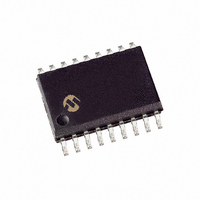MCP2140A-I/SO Microchip Technology, MCP2140A-I/SO Datasheet - Page 54

MCP2140A-I/SO
Manufacturer Part Number
MCP2140A-I/SO
Description
IC IRDA CONTROLLR DTE/DCE 18SOIC
Manufacturer
Microchip Technology
Specifications of MCP2140A-I/SO
Package / Case
18-SOIC (7.5mm Width)
Controller Type
IRDA Standard Protocol Stack Controller
Interface
UART
Voltage - Supply
3 V ~ 5.5 V
Current - Supply
2.2mA
Operating Temperature
-40°C ~ 125°C
Mounting Type
Surface Mount
Product
Controller Area Network (CAN)
Maximum Operating Temperature
+ 85 C
Minimum Operating Temperature
- 40 C
Mounting Style
SMD/SMT
Ic Function
Standard Protocol Stack Controller
Brief Features
Includes UART-to-IrDA Standard Encoder/decoder Functionality, Infrared Supported
Supply Voltage Range
2V To 5.5V
Rohs Compliant
Yes
Lead Free Status / RoHS Status
Lead free / RoHS Compliant
For Use With
MCP2140DM-TMPSNS - BOARD DEMO FOR MCP2140
Lead Free Status / Rohs Status
Lead free / RoHS Compliant
Available stocks
Company
Part Number
Manufacturer
Quantity
Price
Company:
Part Number:
MCP2140A-I/SO
Manufacturer:
MICROCHIP
Quantity:
12 000
Part Number:
MCP2140A-I/SO
Manufacturer:
MICROCHIP/微芯
Quantity:
20 000
MCP2140A
C.1.3
The IrLMP protocol provides:
• Multiplexing of the IrLAP layer. This allows
• Protocol and service discovery. This is
When two devices that contain the IrDA standard
feature are connected, there is generally one device
that has something to do and the other device that has
the resource to do it. For example, a laptop may have
a job to print and an IrDA standard compatible printer
has the resources to print it. In IrDA standard
terminology, the laptop is a Primary Device and the
printer is the Secondary Device. When these two
devices connect, the Primary Device must determine
the capabilities of the Secondary Device to determine if
the Secondary Device is capable of doing the job. This
determination is made by the Primary Device asking
the Secondary Device a series of questions.
Depending on the answers to these questions, the
Primary Device may or may not elect to connect to the
Secondary Device.
The queries from the Primary Device are carried to the
Secondary Device using IrLMP. The responses to
these queries can be found in the Information Access
Service (IAS) of the Secondary Device. The IAS is a list
of the resources of the Secondary Device. The Primary
Device compares the IAS responses with its
requirements and then makes the decision if a
connection should be made.
FIGURE C-5:
DS22050A-page 54
multiple channels above an IrLAP connection
accomplished via the Information Access Service
(IAS)
Parallel
IrLPT
IrLMP
Supported by MCP2140A
Uncooked Services
IRCOMM SERVICE CLASSES
3-wire Raw
Serial
IrCOMM Services
Centronics
IEEE 1284
C.1.4
Each LM-IAS entity maintains an information database
to provide:
• Information on services for other devices that
• Information on services for the device itself
• Remote accessing of another device’s information
This is required so that clients on a remote device can
find configuration information needed to access a
service.
C.1.5
Tiny TP provides the flow control on IrLMP
connections. An optional service of Segmentation and
Reassembly can be handled.
C.1.6
IrCOMM provides the method to support serial and
parallel port emulation. This is useful for legacy COM
applications, such as printers and modem devices.
The IrCOMM standard is a syntax that allows the
Primary Device to consider the Secondary Device a
serial device. IrCOMM allows for emulation of serial or
parallel (printer) connections of various capabilities.
Parallel
contain the IrDA standard feature (Discovery)
base
Note:
LINK MANAGEMENT -
INFORMATION ACCESS SERVICE
(LM-IAS)
TINY TP
IRCOMM
The MCP2140A supports the 9-wire
“cooked” service class of IrCOMM. Other
service classes supported by IrCOMM are
shown in
Cooked Services
Figure
© 2007 Microchip Technology Inc.
C-5.
3-wire Cooked
9-wire Cooked
Serial

















